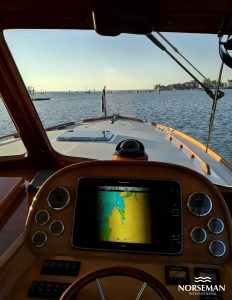Navigating With Confidence

It’s been many years since having not found myself on a boat more days and hours out of the year then in a car. Simply put – my livelihood is constituted from spending a great deal of time navigating the New England waterways. And with the advent of Covid-19 and our new way of life that began just two years ago, new boat owners seemingly arrived en masse overnight which, even for those not spending lots of time on the water, was easily realized.
Now, some may argue that there are already those who shouldn’t be behind the helm for many reasons, least of which being the obvious – they don’t pay attention. But I’m under the impression that with some small adjustments and a bit more hands-on application, both new and tenured can learn to boat safer and with confidence.
Picture this common scenario: You’ve just purchased a new boat and can’t wait to bring your family out for a day in the sun! You’ve had a few hours of training, made sure pertinent paperwork and insurance is in order, and with everyone loaded safety onboard, fire up the engine and head out of the marina, feeling good that you’re in control. Checking left then right before entering into the outbound traffic pattern, you’ve also made sure to take note of the current tidal charts to understand how the currents will affect navigation, as well as any strong windage – both of which for a small (and large) vessel play a huge navigational factor. Looking ahead with your head on a swivel and hyperaware of your surroundings, you spot the red and green aids to navigation and quickly notice boats going on both sides of the buoys – some to the right of the green, some to the left of the red. Rather than panic, you take a breath, ease the throttle back and make sense of the situation before proceeding.
Knowing the area where you’ll be boating is not only critical, but also one of the major points for safe and confident navigation. It’s the difference between questioning yourself because you’re uncertain or questioning the sanity of the boater in front of you – and never assume the boater in front of you knows what they’re doing.
As a rule of thumb, it’s always a great idea to STOP before you go – Stop, Think, Organize and Plan – this will help us remember to be more confident about what we’re about to do and how it’ll potentially affect us on the water.
Written by: Capt. Greg Thornton, Professional Captain Services
For Vessel Deliveries and to learn more, please visit NORSEMAN INTERNATIONAL
